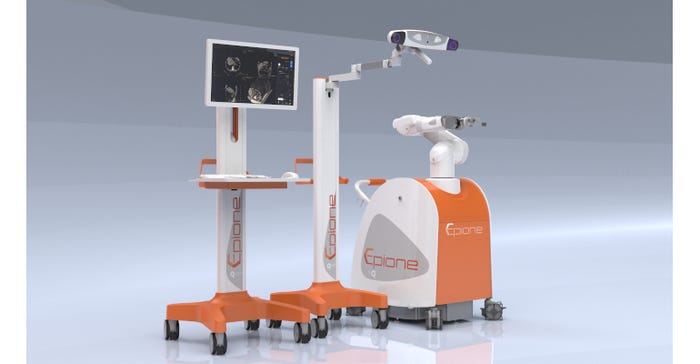Robot and Physician—Working Hand in Hand
The Epione robotic platform from Quantum Surgical collaborates with the physician every step of the way, from planning the procedure to inserting the needle to confirmation of successful treatment.
December 14, 2022

Percutaneous tumor ablation procedures for liver or abdominal cancers are not new. “It's a proven technique. You can go to the hospital, the physician inserts the needle in a 10-minute, microwave ablation session, and there is no scar. You can go home the same day or the day after and the tumor is destroyed,” said Lucien Blondel, chief technology officer at Quantum Surgical, in an interview with Design News.
But Blondel said these procedures can be challenging because they are performed freehand, and the needle has to be placed at just the right position. This can be affected by something as slight as the patient breathing.
The Epione robotic platform from Quantum Surgical collaborates with the physician to plan, execute, and confirm the procedure. “The robot is three elements,” Blondel said. “The first element is the software that enables loading the patient images and planning the needle pathway into the abdomen, so that the needle will be adequately placed relative to the tumor.”
Then a collaborative robot guides the insertion of the needle, keeping track of which phase of the respiratory cycle the patient is in. “What is specific to Epione is the robot is not performing the procedure. The robot is an assistant that precisely positions a guide through which the physician will insert the needle,” Blondel said.
He explained that, with Epione, the physician remains in control because it is important to provide tactile feedback. “When they insert the needle, physicians can feel different tissues. They can feel when they are puncturing the liver capsule, or when they are pushing the tumor away. This is very important information that we want to preserve for the physician,” Blondel said.
Software enables merging before and after images. “You have basically the tumor in one image and what you have destroyed or ablated in the other image,” Blondel said, noting that the merging of images informs the physician about the actual margins that were achieved during the procedure.
Epione is unique in that it facilitates a multiple-needle procedure, which can be necessary for larger tumors, where sometimes up to eight probes must be placed parallel to each other. “For complex procedures that involve more than one needle, then the robot is extremely helpful, and we've designed the robot to account for this,” Blondel said.

Radiation exposure can be decreased while using Epione as well, which benefits both physician and patient. “When you use the robot, it’s possible that you don’t need to use as many control CT scans compared to freehand because the robot is controlling the trajectories,” Blondel said.
And using Epione may increase the number of procedures that can be done, because the robot facilitates the more difficult aspects. “Some interventional radiologists may not want to offer this kind of treatment to their patients because it's still a challenging freehand procedure,” Blondel said. “So, the intent is to standardize how the procedure is performed and enable more physicians to offer these treatments. And for those who already do this on a routine basis, robotics facilitates complicated procedures such as hard-to-reach tumors that are near a vessel a bile duct or another organ at risk.”
Currently, Epione is cleared for use in the abdomen in Europe and for liver ablation procedures in the United States.
About the Author(s)
You May Also Like



